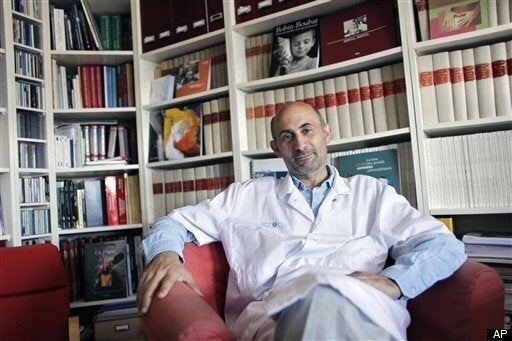
PARIS — A 35-year-old man with a genetic disorder has an entirely new face – including tear ducts that cry, and a chin that sprouts stubble – thanks to a rare full-face transplant performed by a French surgeon and hailed as a new advance in improving the lives of the disfigured.
Dr. Laurent Lantieri, one of the few doctors in the world who has performed face transplants in the past, said Thursday that the patient, named Jerome, "gave me two thumbs up" after the June 27 operation at the Henri-Mondor hospital in the Paris suburb of Creteil.
*SCROLL DOWN FOR VIDEO*
"The patient is doing very well," Lantieri told The Associated Press. "He is very happy, but that is not the final goal for us, a pretty picture. The final goal for us is social re-insertion," or allowing the patient to reconstruct a life not haunted by a deformed face.
Rivals called the French operation, similar to one carried out in Barcelona in April, a new achievement in facial transplants, a procedure that has gradually gained global acceptance and overcome skepticism since the first was conducted in 2005, also in France.
Lantieri claimed the latest surgery was the first involving so many different facial features. The hospital said the operation was the 12th face transplant worldwide since the first conducted in 2005 on the nose, mouth and chin of a woman disfigured by a dog attack.
Replacing eyelids and tiny tear ducts is especially challenging, other surgeons said. The nerves must regrow, and the lids must be sturdy enough to protect the eyes but supple and swift enough to blink.
"We can see that he already has tears, so that's not a problem," Lantieri told AP Television News in his office in Creteil, where skulls adorn his desk. It will be another few months, however, before doctors can be sure the patient can blink correctly, he said.
Hospital workers already have shaved stubble growing out of Jerome's new chin, he said.
Neither Lantieri nor the hospital would give further details about Jerome, including his last name, or the donor, except to confirm that the donor was male.
Dr. Bohdan Pomahac, who has performed facial transplant surgery at Brigham and Women's University in Boston, hailed Lantieri's surgery as "a great confirmation of the principle that we can reconstruct what couldn't be reconstructed before."
"We are still learning," Pomahac said. Lantieri's work shows "a great new avenue to explore."
Surgeons at the Vall d'Hebron Hospital in Barcelona, Spain, said they carried out the world's first full-face transplant in April on a young Spanish farmer unable to breathe or eat on his own since accidentally shooting himself in the face. Doctors lifted the jaw, nose, cheekbones, muscles, teeth and eyelids from a donor and placed it masklike onto the man. The surgeon, Joan Pere Barret, would not comment Thursday on Lantieri's procedure.
A near-total face transplant was carried out in Cleveland in 2008, on a woman who was also shot in the face.
Neil Huband, a spokesman for the UK Facial Transplantation Research Team, based at the Royal Free Hospital in London, congratulated France's Lantieri on a "considerable achievement."
"What does it matter if this is a first, if it gives someone a new life?," he said. When you have a facial injury or disorder, "you walk down the street and you have people who shy away from you, you are called names," he said.
Skeptical bioethicists and doctors' groups have warmed to the idea of facial transplants for patients who have tried reconstructive surgery with little success. After transplants, the patients' faces are not flawless, but they do not look like the dead donors and they are usually free of the tumors or scars that drove them to the extreme surgery.
Like all organ transplant recipients, these patients face the risk of rejection and other complications, and must take immune-suppressing drugs for life.
Doctors said the risks of rejection are not particularly higher with a full face transplant than a partial transplant, nor are the requirements for a donor much more stringent.
The main difference, they said, is time. The latest operation took about 24 hours.
In 2007, Lantieri led the operation on a man to address a rare genetic disorder that left him with such heavy tumors on his lips that it was difficult to speak or eat. Last year, Lantieri led surgery on a man whose face was disfigured by a shotgun blast.
_____
AP Television News producer Ivana Bzganovic in Creteil, France contributed to this report.
WATCH: